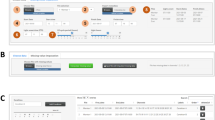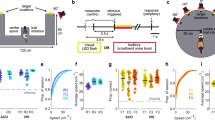Abstract
Replying to C. Barry, D. Bush, J. O’Keefe & N. Burgess Nature 488, 10.1038/nature11276 (2012)
Barry et al.1 propose that it is impossible to detect theta rhythmicity in bat grid cells because of their slow movement velocities and low firing rates; hence, they posit that our findings2 do not refute the oscillatory interference models of mammalian grid cells. To support this claim, they use a data set of rat grid cells of which only 58% were theta modulated, and constrained their analysis to periods of near immobility in the rat, a behavioural state in which theta is known to be absent3. Despite these biases, we argue that their own analysis showed that down-sampled rat cells were substantially more theta-modulated than real grid cells from bats, and we demonstrate further that the bat data have adequate statistical power to detect theta rhythmicity—if it was present in bat grid cells. Finally, Barry et al. focused solely on ‘first generation’ oscillatory interference models, ignoring our disproval of ‘second generation’ models. We thus uphold our original results and interpretation2.
Similar content being viewed by others
Main
Barry et al. analysed a data set of 85 rat grid cells, of which only 58% were significantly theta-modulated to begin with (although oscillatory interference models require 100% of cells to be theta-modulated). The strength of theta modulation in their data was lower than in the much larger data set publically available from the Moser laboratory (a median theta index of 10.9 in Barry et al. compared to 14.23 in data from the Moser laboratory4), which may lower the detectability of theta rhythmicity after the data of Barry et al is down-sampled.
Barry et al. proposed that bats’ slow crawling velocity reduces theta rhythmicity in bat grid cells. Consequently, they selectively removed portions of the rat data, retaining short periods, down to 500 ms in duration, until a median speed of 3.7 cm s−1 was achieved. This procedure has several flaws.
First, although these velocities correspond to an active movement state of bats, they are equivalent to nearly complete immobility in rats5,6. Barry et al. thus compared a state in rats in which theta is not expected3 (near immobility), to a state in bats at which theta, if existing, should be most prominent3 (active movement). Furthermore, in their model, for the constant β (which determines the velocity modulation of dendritic inputs) Barry et al. used a value derived exclusively from rat data7. However, different mammalian species would probably have different velocity dependences in dendritic inputs; for example, when modelling grid cells in cheetah versus sloth, it would not make sense to use a β value taken from rat, and the same goes for the modelling of grid cells in bats. Thus, we contend that movement speed should not be matched, neither when simulating a model nor when down-sampling data from one species to mimic another.
Second, Barry et al. used short portions of near-immobility data, as short as 500 ms in duration, creating very intermittent, unrealistic spike trains; this tapers down the oscillatory cycles (because they estimated 1000-ms autocorrelations using 500-ms data epochs) and could induce an unwarranted statistical bias downwards in detectability of theta rhythmicity.
Third, Barry et al. found that when firing rates were matched to those of bats while movement speed was left untouched, 24% of their theta-modulated grid cells retained significant theta rhythmicity (14% of 58% = 24%); substantially higher than the 4% (1/25) theta-modulated grid cells in bats2. Notably, when Barry et al. analysed the top 51% of their theta-modulated rat grid cells (51% of the 58% modulated cells = 25 neurons)—which are the most relevant cells to consider for their model (especially given the weak theta rhythmicity in their data set)—they found that when firing rates are matched to those of bats and velocities are left untouched, the large majority (72%) of rat grid cells retained significant theta rhythmicity. Thus, down-sampled rat grid cells were markedly more oscillatory than our bat grid cells, supporting our original analysis and interpretation2.
Last, Barry et al. considered only single-cell, first-generation oscillatory interference models of grid cells7,8,9, which have been criticized as theoretically problematic9. Some of these problems have been rectified in recent second-generation versions of these models9, which used networks of coupled oscillators and explicitly predicted network-level theta oscillations9,10. This was contradicted by our bat data, in which brief theta oscillations occurred very rarely in the local-field potential2, and multi-unit firing (reflecting network activity) never showed any theta oscillations2.
In conclusion, we feel that the analysis by Barry et al. fails to support their main argument, namely that the statistical power of the bat data does not allow detecting theta rhythmicity. To resolve this debate, we propose to make use of a large, unbiased, publically available data set of rat grid cells, such as that on the Moser laboratory website, which would allow transparency in analysis techniques and in the baseline rat data being used. Furthermore, we expect that neural recordings from single units in flying bats, in which movement velocities and neuronal firing rates are expected to be much higher, will provide another key approach.
References
Barry, C., Bush, D., O’Keefe, J. & Burgess, N. Models of grid cells and theta oscillations. Nature 488 http://dx.doi.org/nature11276 (2012)
Yartsev, M. M., Witter, M. P. & Ulanovsky, N. Grid cells without theta oscillations in the entorhinal cortex of bats. Nature 479, 103–107 (2011)
Buzsáki, G. Theta oscillations in the hippocampus. Neuron 33, 325–340 (2002)
Sargolini, F. et al. Conjunctive representation of position, direction, and velocity in entorhinal cortex. Science 312, 758–762 (2006)
Jeewajee, A., Barry, C., O’Keefe, J. & Burgess, N. Grid cells and theta as oscillatory interference: electrophysiological data from freely moving rats. Hippocampus 18, 1175–1185 (2008)
Wills, T. J., Cacucci, F., Burgess, N. & O'Keefe, J. Development of the hippocampal cognitive map in preweanling rats. Science 328, 1573–1576 (2010)
Burgess, N., Barry, C. & O’Keefe, J. An oscillatory interference model of grid cell firing. Hippocampus 17, 801–812 (2007)
Giocomo, L. M., Zilli, E. A., Fransén, E. & Hasselmo, M. E. Temporal frequency of subthreshold oscillations scales with entorhinal grid cell field spacing. Science 315, 1719–1722 (2007)
Giocomo, L. M., Moser, M.-B. & Moser, E. I. Computational models of grid cells. Neuron 71, 589–603 (2011)
Zilli, E. A. & Hasselmo, M. E. Coupled noisy spiking neurons as velocity-controlled oscillators in a model of grid cell spatial firing. J. Neurosci. 30, 13850–13860 (2010)
Author information
Authors and Affiliations
Contributions
All authors contributed to writing this reply.
Corresponding author
Rights and permissions
About this article
Cite this article
Yartsev, M., Witter, M. & Ulanovsky, N. Yartsev et al. reply. Nature 488, E2 (2012). https://doi.org/10.1038/nature11277
Published:
Issue Date:
DOI: https://doi.org/10.1038/nature11277
Comments
By submitting a comment you agree to abide by our Terms and Community Guidelines. If you find something abusive or that does not comply with our terms or guidelines please flag it as inappropriate.



